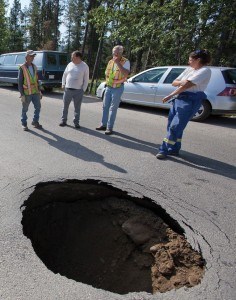
To keep Jasper’s roads, sidewalks, sewers and water distribution system in good repair the municipality will need to spend an additional $1.3 million per year–more than twice what it spends today–according to a recent asset management report.
Currently the municipality spends about $1.2 million per year to fix the town’s roads, sidewalks, sewers and pipes, which is in line with existing needs, however in the long-term the municipality will need to spend about $2.5 million per year to fix and replace these critical pieces of infrastructure.
To cover the additional cost, property taxes would theoretically have to increase by nearly 18 per cent.
“Right now what you’re putting into the system is meeting the needs of today, but it doesn’t match the needs of tomorrow,” said Gordon Molnar, president of Pillar Systems, which completed the report.
In order to meet the town’s current infrastructure needs the municipality will need to spend approximately $6.1 million over the next five years, however this will only sustain the town’s current services and not allow it to tackle its infrastructure deficit.
“The purpose of what we’re doing is two things; one is to develop a short range detailed works program for every infrastructure segment in the network and in the long-term reevaluate your long-range funding plan and determine what the sustainability level is to meet your overall infrastructure plan,” Molnar said during a committee-of-the-whole meeting Jan. 24.
This is the second of three reports produced by Molnar and his company. The first report produced in November 2015, provided a high-level look at the municipality’s infrastructure assets and found the municipality had an annual infrastructure deficit of about $3.3 million.
That means each year there are about $3.3 million worth of maintenance and rehabilitation projects that aren’t being completed on the town’s roads, pipes, wells, facilities and vehicles.
Molnar’s second report, which was presented to council on Jan. 24, is a tactical level study that covers about two-thirds of the town’s infrastructure assets. His next report will cover the town’s facilities, fleet, machinery and water/waste water treatment plants.
The most recent report recommended the municipality implement a five-year capital renewal program and begin building a capital reserve fund for future infrastructure needs by setting aside an additional $1.3 million per year.
The report also concluded that the surface of the town’s roadways are in greatest need of repair and resurfacing them would help extend their life span at a fraction of the cost.
“The problems with the roadways are more surficial, which is expected for any older roadways, but it’s something that can be mitigated quite effectively if done in a timely manner,” said Molnar, adding the town’s sidewalks are in a similar state of repair.
His report recommend the town spend $500,000 per year on roadways over the next five years, then drop spending to about $250,000 per year once it gets on top of things.
If implemented, he estimated the town could resurface about 16 kilometres of road each year for about $340,000 through a technique called micro-surfacing, which is about a quarter of the cost of conventional paving. The remaining money would be used for other repairs.
When it comes to the town’s sidewalks, he suggested the town invest $75,000 per year over the next five years to fix cracked surfaces.
According to Molnar, the town’s wastewater collection system is in reasonably good condition, however some pipes are beginning to show their age, which will require some modest work in the not-too-distant future. On average, he said, the majority of pipelines would need to be replaced in about 30 years.
He suggested the municipality spend $100,000 per year over the next six years before increasing funding to $200,000 annually as pipes begin to reach the end of their lifespan.
He said the water mains are in better-than-expected condition for their age, however the valves are deteriorating at a faster rate than the pipes themselves.
“In the short term there’s a relatively significant amount of valves through the system that will fail that you guys are going to have to repair,” said Molnar.
Over the next five years he suggested spending $500,000 just on valve replacements. In the long term, he recommended the town spend an average of $1.3 million per year to replace the town’s pipelines, the majority of which will likely need to be replaced 14 years from now.
During the meeting Mayor Richard Ireland questioned the report’s conclusions, which recommended the town focus on repairing roads, instead of the town’s underground infrastructure.
“If a road is rough it affects comfort, but if a waterline bursts a business gets shut down, so there’s a different way to look at priorities,” said Ireland.
In response, Molnar reassured the mayor that both the roads and town’s water distribution system would be given nearly equal attention.
“When you look at our recommended spending over the next five years … we have almost an equal amount between the roadways and water so the plan of the attack for both of them is the same level of spending,” said Molnar.
He said the main difference is that it is cheaper to repair the roadways now to extend their life expectancy then replace the entire road, whereas the valves will have to be replaced reactively or until the entire pipeline needs to be replaced.
At the end of his presentation, Molnar suggested the asset management report could be used as a starting point to discuss funding with higher levels of government, while Mark Fercho, the town’s chief administrative officer, said the report would help the municipality.
Paul Clarke
[email protected]
